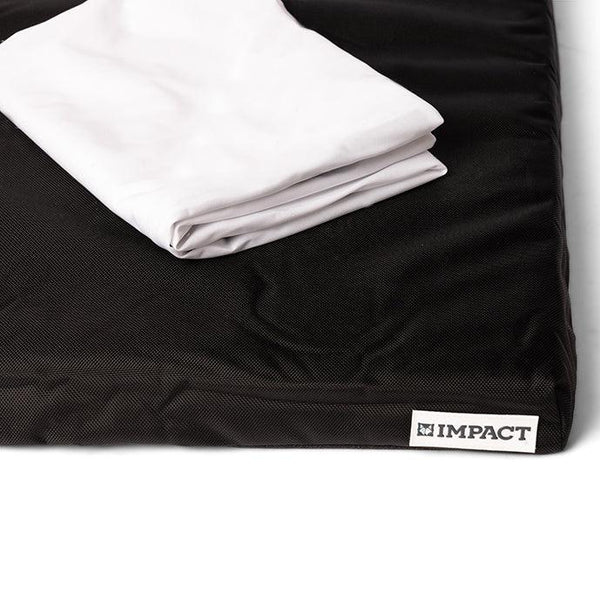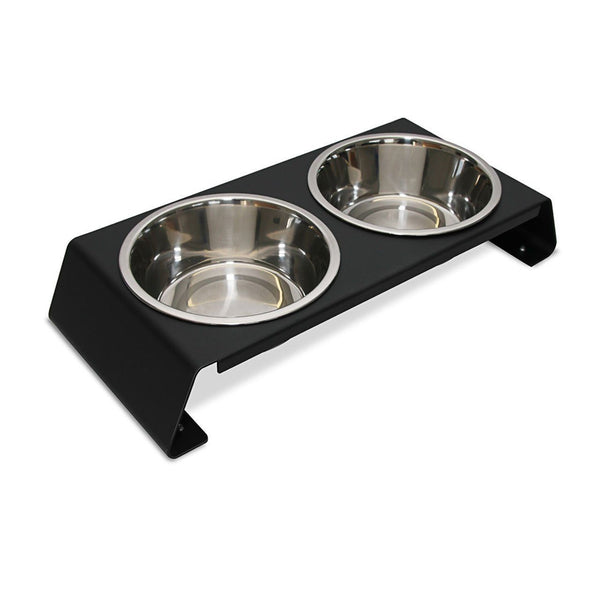If you’re asking ‘how to stop a dog from chewing on their crate,’ you’re seeking immediate, effective solutions, not fluff. Dogs chew on their crates for reasons ranging from anxiety to boredom, and this behavior needs to be addressed for both your dog’s safety and your sanity. In this article, you’ll find direct, actionable steps to help you understand and halt this destructive habit. Learn why pet parents are trusting Impact Dog Crates to provide dogs with the highest quality crate possible.
Key Takeaways
- Identifying the root causes of a dog’s destructive crate behavior (like separation anxiety, boredom, or dental pain) is crucial for finding effective and lasting solutions.
- Proper crate training is essential and should be conducted with positive reinforcement, gradual acclimation, and consistency to ensure a dog feels safe and content.
- Creating a comfortable crate environment with the right size, durable bedding, and appropriate chew toys, alongside providing adequate mental and physical stimulation, can significantly reduce crate chewing.
Why Dog's Chew On Their Crate
Unveiling the root cause of your dog’s destructive crate behavior is the first step towards a chew-free future. Various underlying causes can be at play here, such as separation anxiety, boredom or excess energy, and teething or dental issues.
Realize that the solution extends beyond merely stopping the gnaw. It’s about addressing the psychological needs influenced by the dog’s temperament and your interactions with them. After all, the goal is to find a long-lasting solution, not a temporary deterrent, isn’t it?

Separation Anxiety
Ever wondered what your dog gets up to when you’re not around? Some dogs experience separation anxiety, which can manifest as underlying frustrations like the need to escape or react to noises. Now, imagine being stuck in a dog crate with these feelings - you’d probably start engaging in your dog’s chewing habit too! To keep your dog occupied and alleviate their stress, consider providing toys or puzzles while you’re away.
This destructive behavior is often a desperate attempt to escape and reunite with you. So, the key to managing this issue lies in understanding and addressing this emotional distress.
Boredom and Lack of Stimulation
Imagine being stuck in a room with nothing to do for long periods. You’d likely start looking for ways to entertain yourself, wouldn’t you? Well, your dog is no different. If they’re left in their crate with nothing to stimulate their mind, they’re likely to resort to chewing on it out of sheer boredom.
Fortunately, there’s a solution - food puzzle toys! These toys can engage your dog mentally, making mealtime both challenging and entertaining, and reducing the likelihood of them gnawing at their crate.
Teething and Dental Issues
Teething is a rite of passage for all puppies, and it can be uncomfortable. Chewing is a natural way for them to relieve this discomfort. However, if a crate is the only thing available, it inevitably becomes the chew toy. That’s right, the crate.
Similarly, adult dogs with dental issues may also resort to dog chewing to cope with the pain. Do not worry! Providing appropriate chew toys is an effective solution. These can help your teething puppy or adult dog with dental issues, and save your crate from being their favorite chew toy.
Dog Crate Training Basics
Having understood why dogs might chew on their crates, it’s time to discuss crate training. Yes, it’s as important as training your dog to sit or stay, if not more. Proper crate training can prevent injuries, protect your property, and most importantly, keep your dog happy. On the other hand, improper crate training can lead to undesirable behaviors and stress for your pet.
The process of crate training your dog, also known as crate train, involves:
- Creating a positive association with the crate using treats, toys, and praise
- Acclimating your dog to the crate gradually
- Being consistent in your approach
Let’s delve into further details.
Positive Reinforcement
Positive reinforcement is a powerful tool in crate training. Imagine getting rewarded for doing something you’re unsure about - it suddenly becomes a lot more appealing, doesn’t it? The same principle applies to dogs. Feeding them in their crate, or encouraging them to enter it with a command followed by a treat, can create a positive association.
This way, your dog starts to connect the crate with pleasant experiences, making them more likely to use it voluntarily.
Gradual Acclimation
Remember how daunting it was to jump into the deep end of the pool for the first time? Now, imagine being a dog thrown into a crate without any prior experience - scary, right? Hence, introducing the crate gradually becomes crucial.
Start by placing meals inside the crate, then move to using only the bottom half, and finally add the top as your dog becomes comfortable. This gradual acclimation helps prevent overwhelming your dog and promotes a positive crate experience.
Consistency
Consistency is key when it comes to crate training. Just think about it - if you’re inconsistent, your dog will be too! Maintaining consistency in crate training can effectively address and prevent destructive behaviors like crate chewing.
So remember, be patient, ensure a comfortable environment, and never use the crate as punishment. Your dog will thank you for it!

Creating a Comfortable Crate Environment
Creating a comfortable crate environment is just as important as the training itself. After all, you wouldn’t want to spend time in an uncomfortable room, would you? The same goes for your dog. A cozy crate with the right size, durable bedding, and appropriate chew toys can be a sanctuary for your dog, not a prison.
Let’s explore how you can create this ideal environment.
Right Crate Size
First things first, the right crate size. It should be large enough for your dog to sit, stand, and lie down comfortably. But remember, too much space can encourage unwanted behaviors, like eliminating in the crate. So, how do you find the right balance? Measure your dog’s height and length, add a few inches, and voila - you have your crate dimensions.
And for those growing puppies out there, consider an expandable crate. It’ll save you a lot of hassle - and money - in the long run.
Durable Bedding
Next up, bedding. Remember, comfort is key here, but so is durability. And when it comes to withstanding the jaws of a persistent chewer, nothing beats chew-proof armored beds or ballistic tough & durable beds. They’re not just durable, they’re also water-resistant and easy to clean. Plus, they come with a chew-proof warranty - now that’s what we call a win-win! Don’t forget to also provide your furry friend with durable chew toys to keep them entertained and satisfied.
Appropriate Chew Toys
Last but not least, chew toys. These can be your secret weapon in the battle against crate chewing. But not just any chew toys - they need to be safe, suitably sized, and durable enough to withstand intense chewing.
Plus, they can be a lifesaver for teething puppies or adult dogs with dental issues, providing them with a much-needed outlet for their chewing needs. So go ahead, stock up on those chew toys and watch your dog’s crate chewing habits fade away.
Mental and Physical Stimulation
Preventing destructive crate behavior isn’t just about the right crate or training; it’s also about keeping your dog engaged and calm. And that’s where mental and physical stimulation come in. Think about it - an active dog is a happy dog, right? And a happy dog is less likely to resort to destructive behaviors like crate chewing.
Now, let’s discuss methods to provide your dog with adequate mental and physical stimulation.
Exercise
When it comes to reducing destructive crate behavior, never underestimate the power of good old physical exercise. It’s not just about wearing out your dog physically, it’s also about providing them with the mental stimulation that comes from exploring their surroundings. Regular physical activity can help divert your dog’s energy away from destructive chewing, making them calmer and more content.
And remember, the amount of exercise needed can vary based on your dog’s age, health, and breed, so be sure to keep these factors in mind.
Interactive Play
Interactive play is another crucial element in preventing destructive crate behavior. It not only contributes to your dog’s mental well-being but also helps to reduce tendencies towards destructive behavior.
So go ahead, play fetch, tug-of-war, or whatever game your dog enjoys. It will not only help keep your dog’s crate chew-free but also strengthen the bond between you and your furry friend.
Puzzle Toys
Lastly, it’s worth discussing puzzle toys. These are not just toys, they’re mental workout equipment for your dog. By providing mental stimulation, puzzle toys can redirect your dog’s chewing behavior away from the crate. Plus, they can also make mealtime more challenging and entertaining, especially for those fast eaters out there.
So next time you’re shopping for your dog at your local pet store, consider adding some puzzle toys to your cart.
Handling Separation Anxiety
Separation anxiety can be a tough nut to crack, but it’s not impossible. With the right approach, you can help your dog manage their anxiety and prevent destructive crate behavior. This can involve:
- Consulting a professional dog trainer or behaviorist to develop a behavior modification plan
- Creating a calming environment using pheromone sprays
- Considering calming supplements or medications
Remember, it’s about helping your dog feel safe and secure, even when you’re not around.
Preventive Measures and Solutions
Sometimes, despite your best efforts, your dog might continue to chew on their crate. But don’t lose heart - there are preventive measures and solutions you can try. These include:
- Using bitter-tasting sprays to discourage chewing
- Reinforcing the crate with durable materials to prevent damage
- Considering alternative confinement options if necessary
Let’s explore these solutions in more detail.
Bitter-Tasting Sprays
If your dog has a penchant for chewing on their crate bars, bitter-tasting sprays can come in handy. Let’s be honest, nobody likes the taste of bitter apple, right? Well, dogs are no different. By applying a bitter-tasting spray to the crate, you can deter your dog from chewing on it.
It’s a simple solution, but it can be very effective.
Reinforcing the Crate
When it comes to preventing crate chewing, sometimes, you need to think outside the box - or, in this case, the crate. Reinforcing the crate with durable materials like metal sheets or panes can deter your dog from chewing. You can also secure the crate door with heavy-duty latches to prevent your dog from opening it.
It might seem like a lot of work, but trust us, it’s worth it.
Alternative Confinement Options
If your dog continues to exhibit destructive behavior despite your best efforts, it might be time to consider alternative confinement options. This could involve using playpens, dog-proofing a room, or even creating an indoor outdoor enclosure. Remember, the goal is to provide a safe and comfortable space for your dog that also prevents them from damaging property.
Impact High Anxiety Dog Crate
At Impact Dog Crates, we understand the challenges of dealing with destructive crate behavior. That’s why we’ve designed the Impact High Anxiety Dog Crate. This crate is specifically built for dogs that display destructive behavior or suffer from high anxiety.
Constructed from heavy-duty aluminum, it provides a secure and comfortable environment for your dog. Plus, with a 10-year Dog Damage Warranty, you can feel confident knowing that we’ve got your back.
Frequently Asked Questions
What are some signs of destructive crate behavior in dogs?
If your dog is pawing and scratching at the crate, attempting to escape, defecating or urinating in the crate, or chewing objects inside the crate, these are signs of destructive crate behavior. It's important to address these behaviors to ensure the well-being of your dog.
What are some solutions to address destructive crate habits in dogs?
To address destructive crate habits in dogs, consider crate training, ensuring plenty of exercise, creating a comfortable crate environment, and seeking expert advice if the behavior continues. These steps can help correct the issue effectively.
What is the Impact High Anxiety Dog Crate?
The Impact High Anxiety Dog Crate is designed for extremely anxious or destructive dogs, providing a comfortable and secure environment with its heavy-duty aluminum construction. It aims to give peace of mind to pet owners and ensure the safety of dogs.






